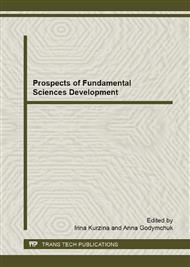[1]
C. Buzea, I.I. Pacheco, K. Robbie, Nanomaterials and nanoparticles: sources and toxicity, Biointerphases. 2 (2007) 17-71.
DOI: 10.1116/1.2815690
Google Scholar
[2]
S. Hashmi, Comprehensive Materials Processing, Elsevier, New York, (2014).
Google Scholar
[3]
G. Oberdörster, E. Oberdörster, J. Oberdörster, Nanotoxicology: an emerging discipline evolving from studies of ultrafine particles, Environ. Health Persp. 113, 7 (2005) 823-839.
DOI: 10.1289/ehp.7339
Google Scholar
[4]
P. Kumar, A. Robins, S. Vardoulakis, R. Britter, A review of the characteristics of nanoparticles in the urban atmosphere and the prospects for developing regulatory controls, Atmos. Environ. 44 (2010) 5035-5052.
DOI: 10.1016/j.atmosenv.2010.08.016
Google Scholar
[5]
X. He, W.G. Aker, J. Leszczynski, H. Hwang, Using a holistic approach to assess the impact of engineered nanomaterials inducing toxicity in aquatic systems, J. Food Drug Anal. 22 (2014) 128-146.
DOI: 10.1016/j.jfda.2014.01.011
Google Scholar
[6]
E. Navarro, A. Baun, R. Behra, N.B. Hartmann, J. Filser, A. -J. Miao, A. Quigg, P.H. Santschi, L. Sigg, Environmental behavior and ecotoxicity of engineered nanoparticles to algae, plants, and fungi, Ecotoxicology. 17 (2008) 372-386.
DOI: 10.1007/s10646-008-0214-0
Google Scholar
[7]
S. Eduok, B. Martin, R. Villa, A. Nocker, B. Jefferson, F. Coulon, Evaluation of engineered nanoparticle toxic effect on wastewater microorganisms: Current status and challenges, Ecotox. Environ. Safety. 95 (2013) 1-9.
DOI: 10.1016/j.ecoenv.2013.05.022
Google Scholar
[8]
R.D. Handy, F. von der Kammer, J.R. Lead, M. Hassellov, R. Owen, M. Crane, The ecotoxicology and chemistry of manufactured nanoparticles, Ecotoxicology. 17 (2008) 287-314.
DOI: 10.1007/s10646-008-0199-8
Google Scholar
[9]
P. Sanderson, J.M. Delgado-Saborit, R.M. Harrison, A review of chemical and physical characterisation of atmospheric metallic nanoparticles, Atmos. Environ. 94 (2014) 353-365.
DOI: 10.1016/j.atmosenv.2014.05.023
Google Scholar
[10]
Z. Gauptman, Yu. Grefer, H. Remane, Organic Chemistry, Himiya, Мoscow, (1979).
Google Scholar
[11]
O.V. Karban, O.L. Khasanov, Investigation of zirconia nanoceramics microstructure, Phys. of Low-dimensional Struct. 3 (2003) 297-308.
Google Scholar
[12]
Yu.A. Kotov, The electrical explosion of wire: a method for the synthesis of weakly aggregated nanopowders, Nanotechnol. in Russia. 4, 7-8 (2009) 415-424.
DOI: 10.1134/s1995078009070039
Google Scholar
[13]
O.B. Nazarenko, Electroexplosive nanopowders: production, propertoes, application, Tomsk State University Ed., Tomsk, (2005).
Google Scholar
[14]
A. Yu. Godymchuk, G.G. Savel`ev, D.V. Gorbatenko, Dissolution of copper nanopowders in inorganic biological media, Russ. J. Gen. Chem. 80, 5 (2010) 881-888.
DOI: 10.1134/s1070363210050026
Google Scholar
[15]
W. Kreyling, M. Semmler, F. Erbe, Translocation of ultrafine insoluble iridium particles from lung epithelium to extrapulmonary organs is size dependent but very low, J. Toxicol. Env. Health. 65A, 20 (2002) 1513-1530.
DOI: 10.1080/00984100290071649
Google Scholar
[16]
J. Ni, Q. Wu, Y. Li, Z. Guo, G. Tang, D. Sun, F. Gao, J. Cai, Cytotoxic and radiosensitizing effects of nano-C 60 on tumor cells in vitro, J. Nanopart. Res. 10 (2008) 643-651.
DOI: 10.1007/s11051-007-9295-6
Google Scholar


